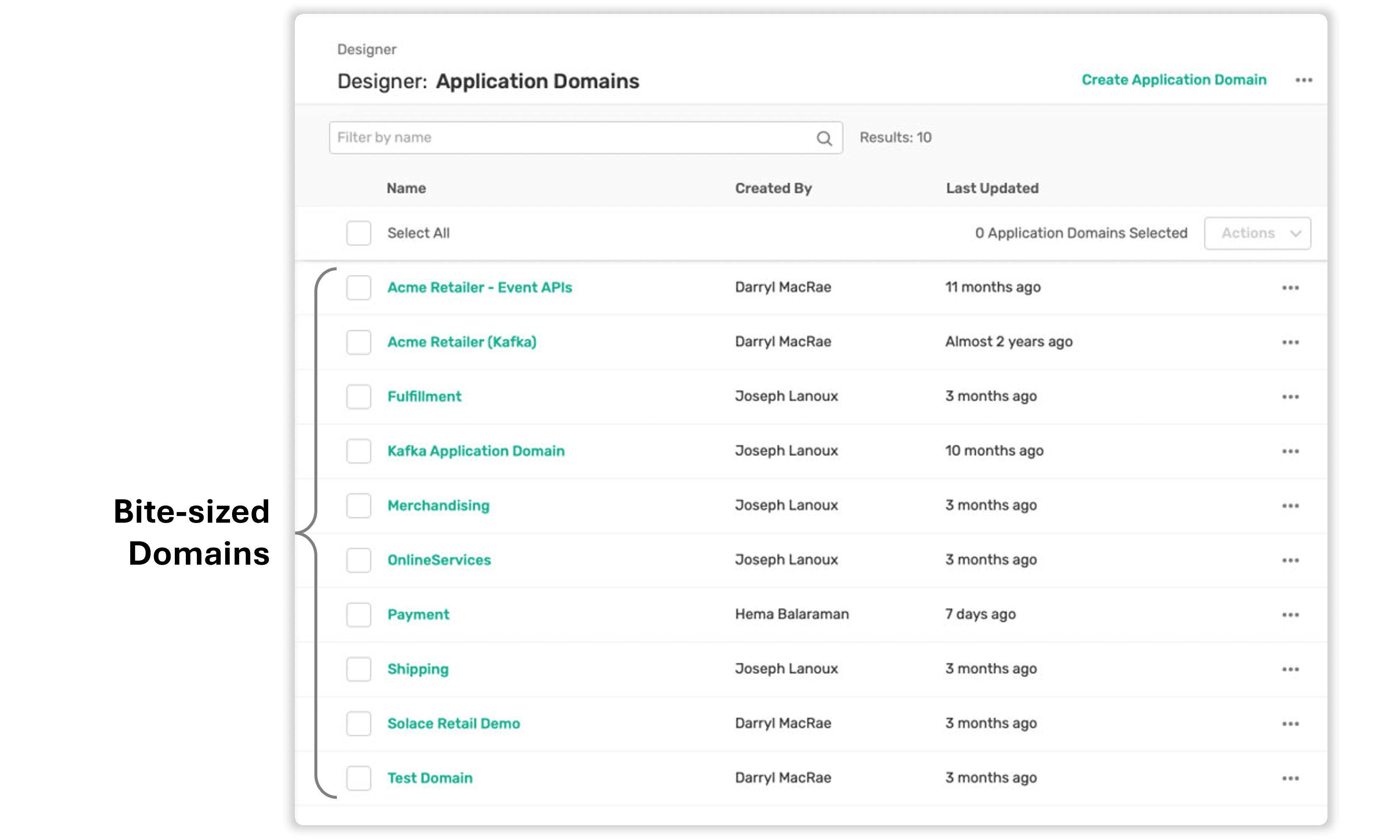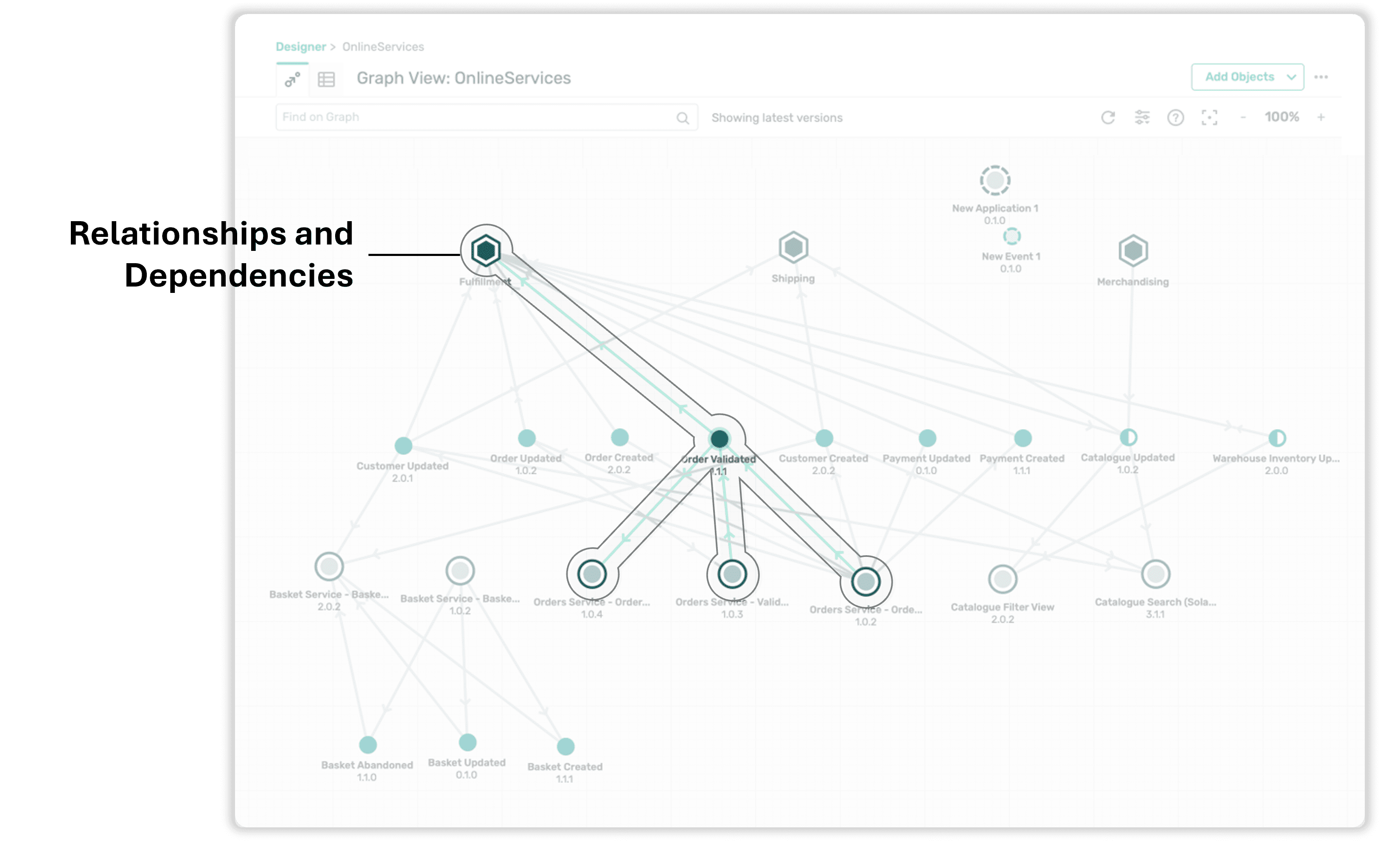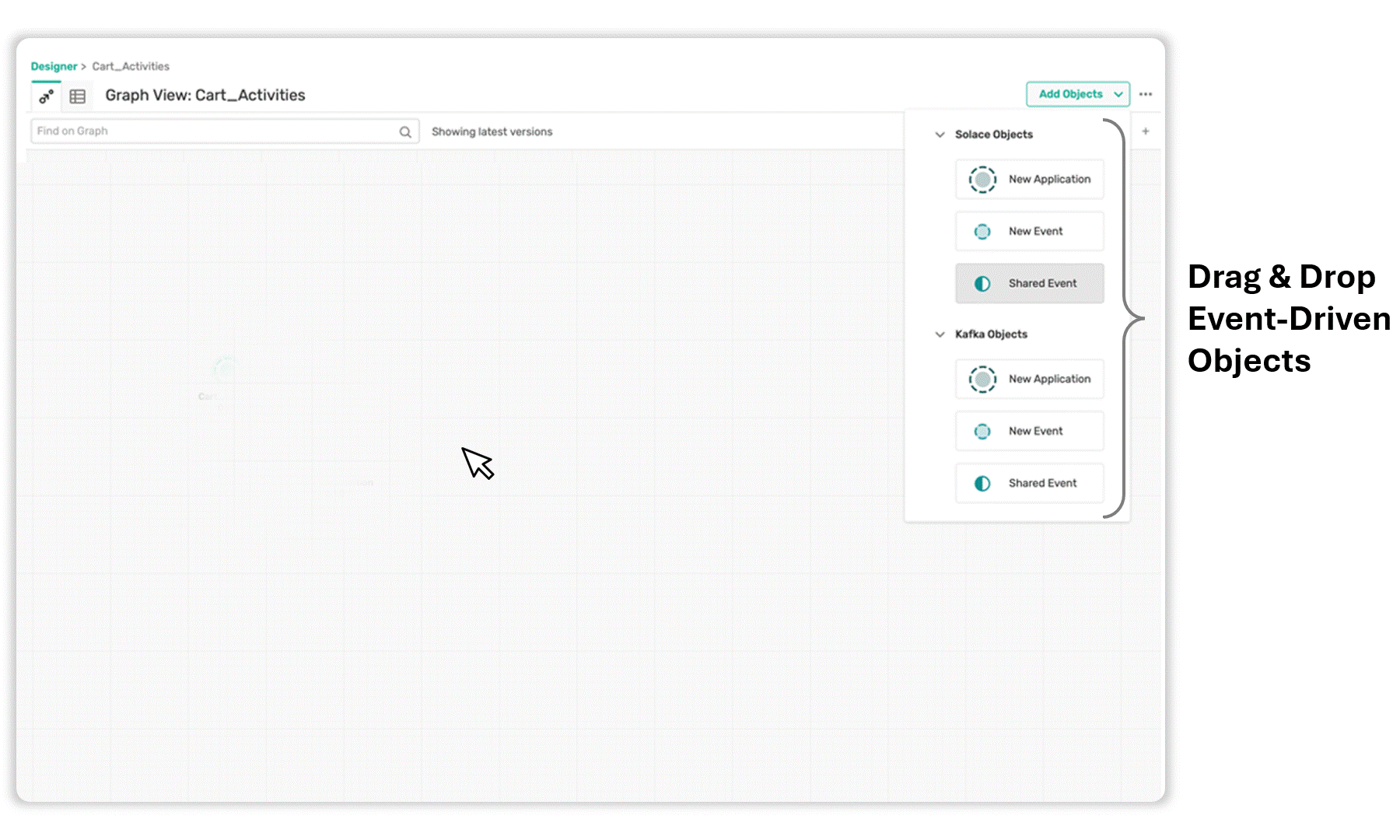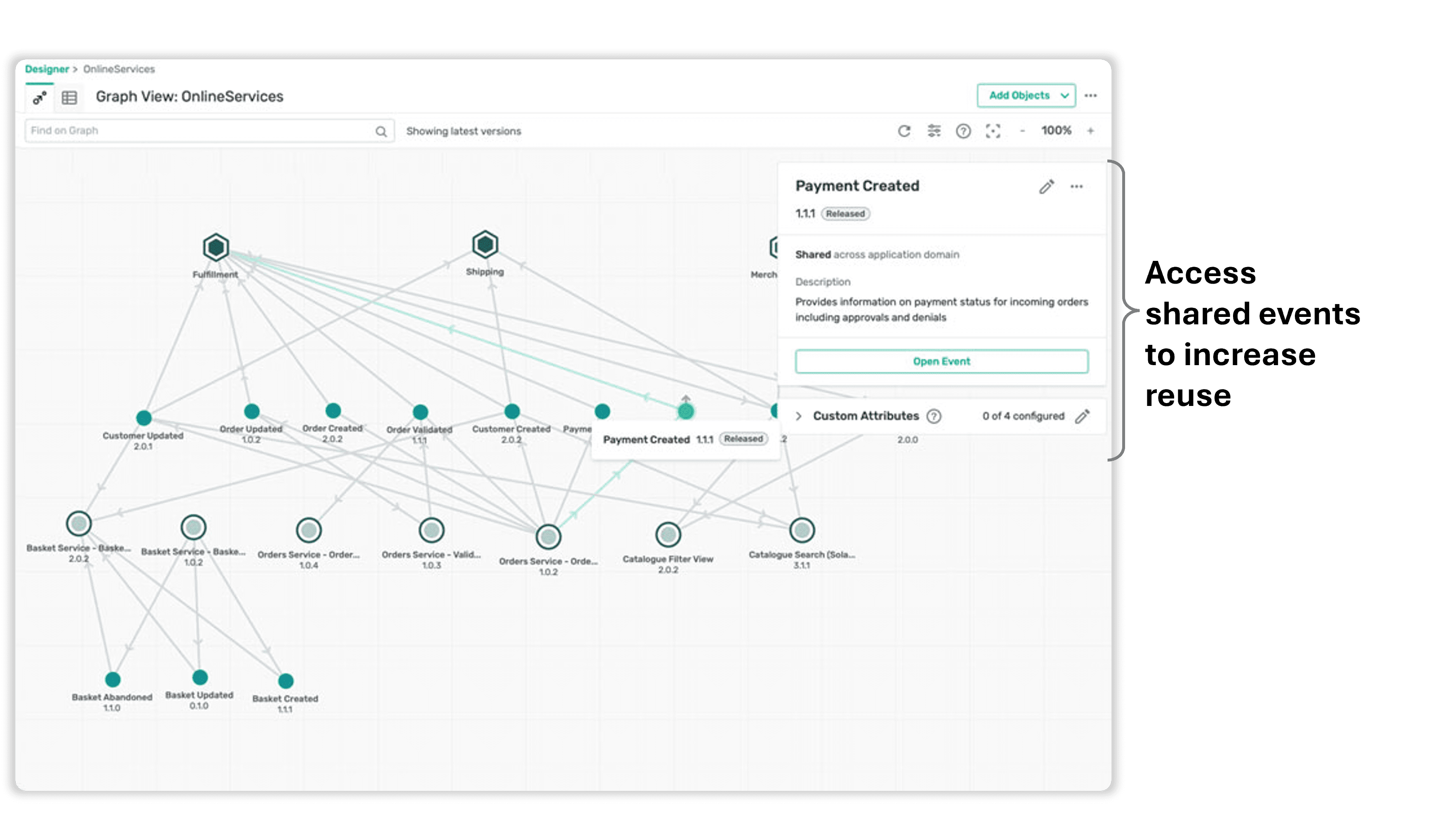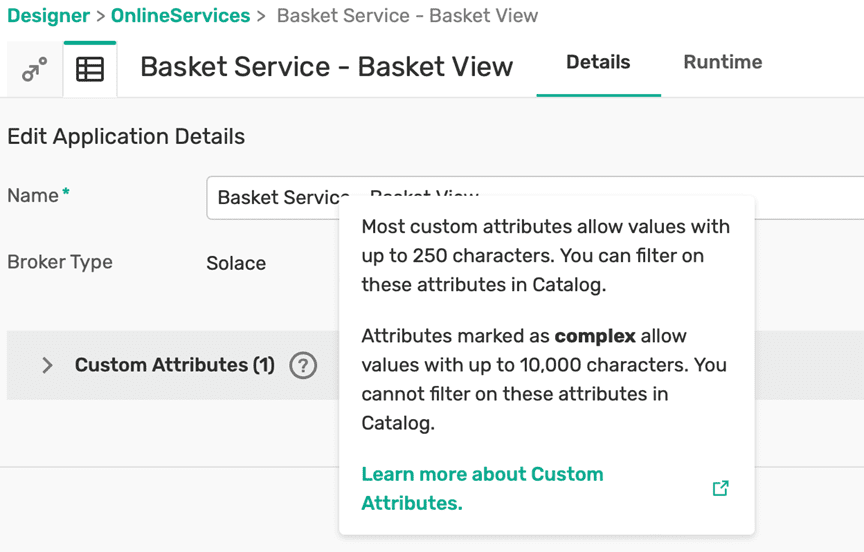Sometimes for major developmental initiatives, designing event-driven application involves many stakeholders collaborating through various brainstorming sessions and whiteboarding ideas. This gives rise to several documentations across spreadsheets, Visio diagrams and various forms of whiteboards that architects and developers need to go through to gain clear understanding of their end points and collaborate and design the flow of event streams between their applications.
In addition, the ramp up time needed for a new developer to get to know the ins and outs of your system becomes inefficiently long when they must go through thousands of these documentations – which are sometimes outdated.
Solace Event Portal offers a solution with its low-code graphical designer where developers architects, SMEs and business owners collaborate in a single place. and visualize the architecture of your applications and the dependencies between them. It also simplifies onboarding new developers by empowering them with a full view of your application architecture at the click of a button. Here are some of the capabilities of Event Portal that help you efficiently design, visualize, document and lifecycle manage your event-driven components.
Visualize your Event-Driven System
To design your event-driven system, you need a clear understanding of its structure. Whether you’re starting from scratch or updating your EDA as your business grows, you need clarity on what applications exists, which is the latest and most relevant version of them, and how they interact with each other.
Solace Event Portal provides an easily understandable visual representation of your event-driven system.
Boundaries for Clear Structure
Bring clarity to your system by assigning a domain to every functional area in your organization. This breaks your larger enterprise into bite-sized pieces for better access, control and focus. Within a domain, developers have the freedom to bounce ideas off each other as they perfect the design.
Version Control
Track all the changes made to your event-driven components through semantic versioning. Each time any of the objects in your EDA – applications, events, schemas, etc., – is updated, they can be saved as a new version and this version can also be attached to one of the lifecycle states – draft, released, deprecated, retired. Versioning lets you update and test objects in a development environment while keeping the previous version in production.
Dependency Mapping
Gain a clear picture of the relationships and dependencies within your event-driven system to be able to perform a comprehensive change-impact analysis. Understanding these connections allows you to see how changes to one component may affect others, ensuring that updates and modifications are made with full awareness of potential impacts. This holistic view helps prevent unexpected issues, improves system reliability, and facilitates more informed decision-making.
Collaborate your Way to Success
We know that building an event-driven system is not a one-person job. It takes a heavy dose of collaboration between developers, architects, and middleware team members to ideate and design an effective event-driven application. However, when this collaboration is not done systematically, it leads to disparate documentation that lead to inconsistencies and inefficiencies when it comes to translating your ideas to reality, prolonging your development time.
Solace Event Portal tackles this challenge by providing a collaborative space where all the stakeholders can work together in shaping their ideas into implementable designs.
Event Storming using a GUI
Brainstorm and design your event-driven system in Event Portal’s graphical designer – the drag-and-drop canvas in Solace Event Portal. This intuitive interface allows developers and architects to quickly and efficiently create/modify application interfaces with the ease of dragging and dropping the event-driven objects into the canvas. As they work together, they can easily determine which events should be sent and received by which applications, fostering collaboration and making it easy for your team to refine your event-driven choreography together.
Encourage Event Reuse
When designing event-driven systems, the optimal solution involves a mix of events from both within and outside the application domain. Event Portal simplifies this process by allowing you to pick and choose vents from various sources. This increases the consumption of events by multiple applications, thereby increasing the event reuse – a key indicator of EDA efficiency.
Enrich Information with Custom Attributes
Adding custom attributes to your application domain or its objects enriches the information about event-driven components. This enhancement makes it easier for everyone in your organization to search for and understand these objects.
Bring your Designs to Life
Once you and your team have designed the choreography of your events flow between the applications, it’s time to add the business logic, get the interfaces to connect with the outside world and make the application come to life. Code generation is a crucial part of this stage of the development cycle that enables organizations to leap from interface to implementation without mountains of laborious manual code.
AsyncAPI Code Generation
Focus on business logic, not repetitive code, with automatic scaffolding generation for various development environments. Every application in Event Portal can be represented by an AsyncAPI. With just two clicks, you can export the application interfaces as an industry standard AsyncAPI spec. This AsyncAPI then gets fed directly into a code generator, eliminating the need for copy-pasting and reducing the risk of misinterpretation.
Generate Code Within your Existing Tooling
Extend and customize integrations to perfectly suit your needs – be it code gen for iPaaS tools like Boomi, Mulesoft or SAP or custom applications that use a more Java oriented approach, like Spring. AsyncAPI code gen templates provide multiple options and the ability to create your own, leveraging existing open-source tooling.
Start Your Free Trial
Designing, visualizing, documenting, and managing event-driven applications can be challenging. Solace Event Portal simplifies this process, enhancing collaboration and efficiency. If you’re ready to simplify the way you design your event-driven system, try Solace Event Portal for free today!

